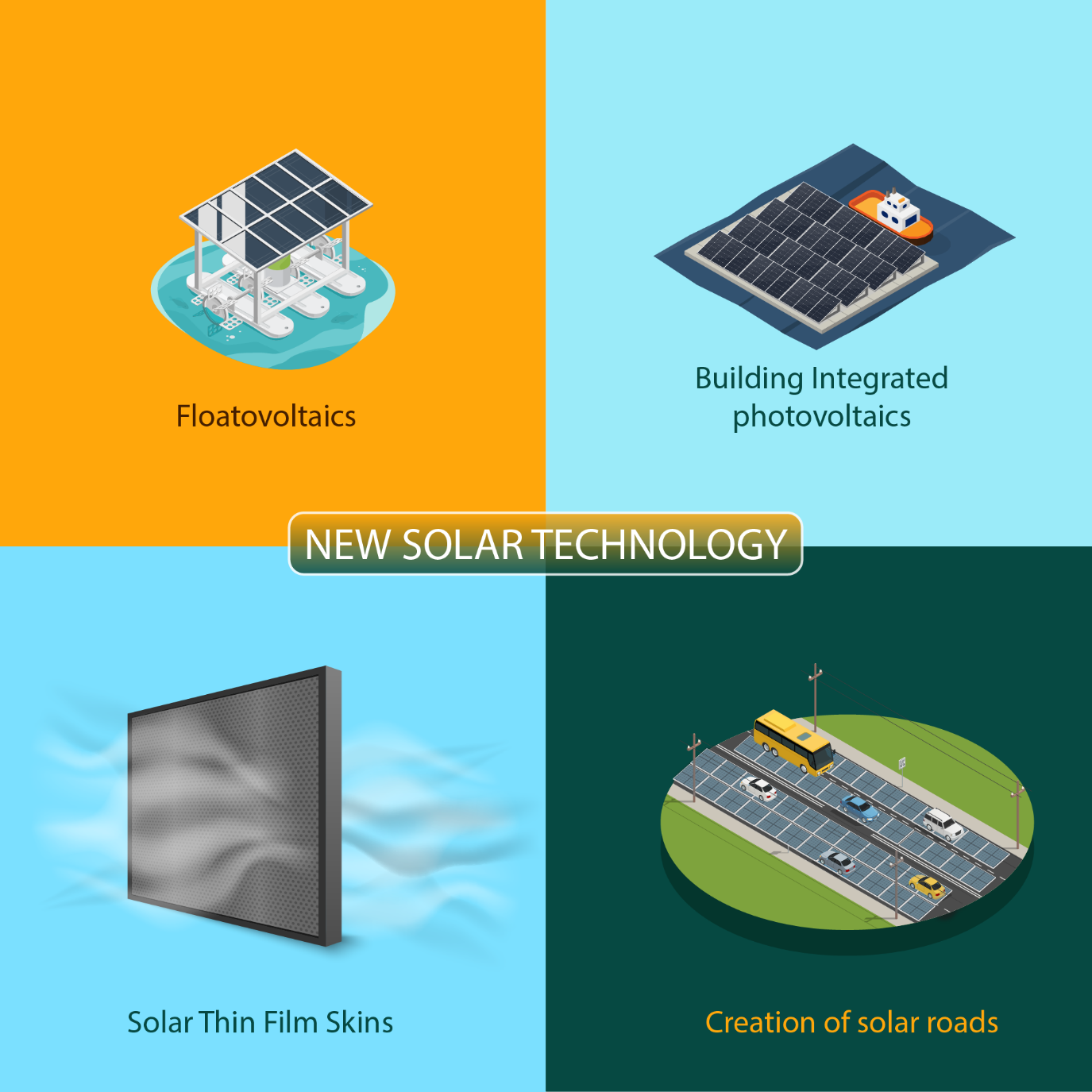New Solar Technology: Changing the Energy Game for a Sustainable Future
Solar panel technology has come a long way in recent years, with advances in materials and design leading to more efficient and cost-effective systems for generating electricity from the sun. Solar energy has become popular in recent years as a clean and renewable source of electricity. There have been several advances in solar technology that have made it more efficient and cost-effective.

But, when you think about solar power the old rooftop technologies came to our mind. In the twenty-first century, a lot of advancements have been occurring in the solar technological field. Now a day solar panels don’t require a lot of land for their installation and their installation cost is getting economical by the day. So, we can say that the new solar technology is the torch bearer in the field of clean renewable, and sustainable solar energy.
Points to remember:
Important Points To Remember
- The new solar technology is the torch bearer in the field of clean renewable and sustainable solar energy.
- Solar PV modules are made up of silicon.
- Solar PV modules can generate electricity on cloudy days. But the efficiency rate is slightly less as compared to the sunny day.
- The technologies like photovoltaics, BIPV, thin film skins, and solar roads have revolutionized the game of solar power production.
- Solar panels are a promising option for the future of sustainable electricity production.
What’s in this Article?
- How do traditional solar panels generate energy?
- Do the Solar PV modules work on cloudy days?
- What is the new solar technology that raging in the US solar market?
- Floatovoltaics
- Building Integrated photovoltaics
- Solar skins or solar thin film skins
- Creation of solar roads
- Is there any solar panel that works without sunlight?
- What is the future of solar technology?
How do traditional solar panels generate energy?
To understand how new technology is revolutionizing the solar power world. We need to first take a glance at how the traditional solar panel working takes place. Solar panels also known as photovoltaic solar PV modules have silicon embedded in their plates. It produces electricity when sunlight hits the surface of the solar panel causing the excitation of electrons. The movement of this electron is responsible for electricity production.
Do the Solar PV modules work on cloudy days?
The most common question that bothers the homeowner is that. Will our solar panels be able to work on cloudy days? To answer this question it is reported that solar panels can produce electricity on cloudy days, but they are generally less efficient at doing so than on sunny days. This is because clouds block some of the sunlight that would otherwise reach the solar panels, reducing the amount of energy that they can generate.
However, solar panels are still able to produce electricity on cloudy days because they can capture some of the light that can pass through the clouds. Although the amount of electricity produced by solar panels on cloudy days may be less than on sunny days. But they are still able to generate some electricity.

What is the new solar technology that raging in the US solar market?
There is a lot of new technology in the solar technological field. Which include the use of alternative materials for photovoltaic cells, the development of thin-film solar panels and solar shingles, the use of concentrated solar power systems, the introduction of solar water pumping systems, the integration of solar panels into building envelopes, and the creation of solar roads. These technologies have the potential to significantly increase the use of solar energy and help reduce the reliance on nonrenewable resources like fossil fuels.
The new solar technologies could be classified into the following types:

Floatovoltaics:
Fhotovoltaics mount photovoltaic panels on water reservoirs. FV gave us the benefit of land conservation and the initial installation cost is less than the land-based solar system. Floatovoltaics have one more advantage that is they produce ten percent more energy. This happens due to the cooling effect of the solar panels caused by water bodies.
Building Integrated photovoltaics:
As the name suggests. In BIPV’s new solar technology, the solar panels are mounted within the architecture of buildings. BIPV is effective for two purposes. BIPV not only brings down the construction material cost required by the building. These panels also save a lot of space. So, it is like killing two birds with one stone you get to build buildings and houses at an economical rate while conserving the space required by the solar panel installation.
Solar skins or solar thin film skins:
These are the latest technology in the field of solar PV module systems. In solar thin film skins, custom designs are integrated into solar systems. These designs could be made to match your rooftop, and lawn grass or could be molded into logo and flag designs as well. These types of solar panels provide far greater aesthetics than any other new solar technology available in the solar market.
Apart from better aesthetics, the thin film skin’s efficiency rate is also quite high. This is due to the usage of their technique of selective light filtration. They only absorb a certain wavelength of light to maximize electrical power production by solar panels.
Creation of solar roads:
Solar roads are considered new in the solar technological field. Approximately, 3000 miles of US highways are paved by solar panels. These roads are not only productive in solar power production but also help us in alleviating the noise pollution caused by traffic. Hence, acting like a traffic noise barrier. According to an estimate, the potential of such solar roads is around four hundred gigawatts hours annually. Which roughly equates to providing electricity to 37,000 US residential homes annually.
Is there any solar panel that works without sunlight?
Yes, there are certain solar panels available in the solar market. which can produce electrical power without sunlight. This new solar technology can bypass intermittent weather patterns. These solar panels utilize high-power radiation like gamma or ultraviolet radiation to generate electrical power. But this technology is under experimentation and is not available for commercial or residential scales.
What is the future of solar technology?
The advances ins solar technology in recent years have made solar panels a viable and attractive option for generating electricity. The above-mentioned technologies have all contributed to the increasing popularity of solar energy. These technologies have the potential to significantly increase the use of solar energy and help reduce our reliance on fossil fuels.

However, it is important to note that solar energy is not a one size fits all solution. Factors like location, available space, initial installation cost, and weather patterns affect the working of solar panels. Despite these considerations, the potential benefits of solar energy are far greater. hence, making it a promising option for the future of sustainable electricity production. As technology continues to improve and cost decrease, solar energy will likely play an increasingly important role in meeting our energy demands.
